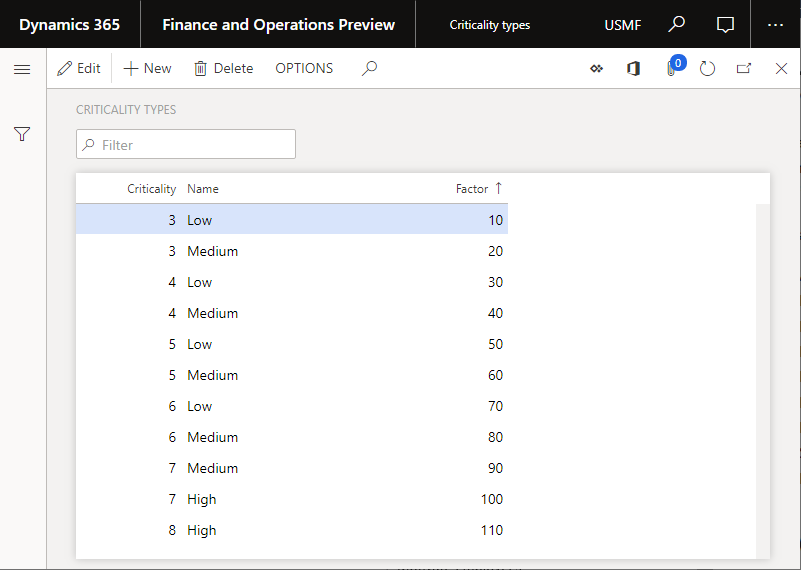Asset criticality types
The article explains asset criticality types in Asset Management. Asset criticality is related to assets and is transferred to work orders. It can't be changed on a work order. Asset criticality is used to calculate work order criticality during work order scheduling. In other words, it's used to calculate the extent to which a maintenance job on an asset affects the production schedule and productivity in your company. For more information about the setup that is related to the calculation of rating scores for work order scheduling, see Asset Management parameters.
To set up criticality, you first create the criticality types that should be used in the asset setup. You then set up asset criticalities.
Set up criticality types
Select Asset management > Setup > Assets > Criticality types.
Select New to create a record.
In the Criticality field, enter a number that indicates the criticality.
In the Name field, enter a name for the criticality type.
In the Factor field, enter a factor. This factor is used during the calculation of work order scheduling to determine the criticality record that should be used. (The record that has the highest factor is always used.) This setting is relevant if, as shown in the following illustration, criticality lines are created that have the same criticality value.

Set up asset criticalities
Select Asset management > Setup > Asset criticalities.
Select New to create a record.
Depending on the required level of detail for asset criticality, make relevant selections in the Functional location, Asset type, Manufacturer, Model, Asset, Job type category, Job type, Job type variant, and Job requirement fields.
Note
When an asset criticality is selected, Asset Management goes through all asset criticality records to check for a possible match. It always checks the most specific combination first. In other words, Asset Management first checks Job requirement. If no match is found, it checks Job type variant. If no match is found, it checks Job type, and so on. As you can see in the layout of the page, this behavior means that, to find the most specific combination, Asset Management checks each record from right to left for a match. If no match is found, the "default" record that has no selections is used.
In the Criticality field, select one of the criticality values that you created in the previous procedure.
Notes about criticality setup
- If you change an asset criticality in this setup after you've already used it on a work order, the criticality on the work order isn't updated accordingly.
- The criticality on a work order is recalculated every time that a work order line is added to or deleted from the work order.
- If a work order contains several work order jobs, the highest criticality, according to the Factor field on the Criticality types page, is always used on the work order.
- Generally, asset criticality can change over a period. Criticality can be affected by the purchase of new equipment, refurbishments, and so on. Consider reevaluating your asset criticalities at regular intervals (for example, once per year or every other year) to make sure that your criticality definitions match your current production setup.
Feedback
Coming soon: Throughout 2024 we will be phasing out GitHub Issues as the feedback mechanism for content and replacing it with a new feedback system. For more information see: https://aka.ms/ContentUserFeedback.
Submit and view feedback for